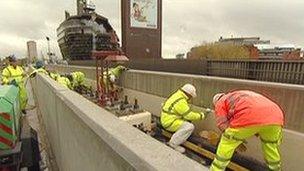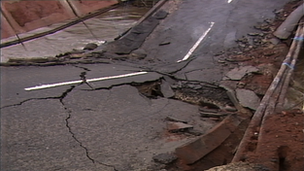TfL report warned of Hammersmith Flyover collapse risk
- Published
Hammersmith Flyover is used by 90,000 vehicles a day
A major London road remained open for weeks after a report warned of a small risk it could collapse at any moment.
Hammersmith Flyover, used by 90,000 vehicles a day, was shut on 23 December 2011 as salt water from gritting had rotted internal steel cables.
But a draft report obtained by BBC London showed months earlier Transport for London (TfL) knew it could have seen a "sudden catastrophic collapse".
TfL said monitoring suggested a "number of years of life" left in the bridge.
The Emergency Preparedness Plan, which was written on 29 October 2011, was obtained through a Freedom of Information request.
It also detailed how TfL would respond to a collapse, outlining co-operation with emergency services, an exclusion zone, debris removal and PR strategy.
'Remote possibility'
The report reads: "The immediate plans are to install some form of temporary structure beneath the flyover, to strengthen it and prevent the likelihood of a sudden collapse, however remote the possibility.
"It is likely to be 3‐4 months before construction can commence.
"Until this structure is in place there is a very remote possibility that Hammersmith Flyover will collapse."

The flyover was damaged by salt water
Not only does the high structure carry heavy traffic, but roads and pedestrians pass underneath.
John Knapton, a highway engineer and concrete expert, said: "The report was saying if the bridge collapsed it would do so without any warning whatsoever - and would be more likely to do so when traffic was there, because of the weight.
"There is also the danger of things going on beneath the flyover. You would expect fatalities."
Mr Knapton, who advised the government on lessons learned from the Twin Towers collapse, argues at the very least TfL should have put in place a 7.5 tonne weight restriction.
But this was not done.
A TfL spokesman admitted a strengthening prop system only came into effect on 27 November.
That means the at-risk bridge was open to all traffic - without additional support - for more than four weeks after the collapse warning.
Mr Knapton said there have been similar "catastrophic" bridge collapses in the US and developing countries.
And Ynys-y-Gwas Bridge in south-west Wales - built to a similar design as the flyover - suddenly collapsed in 1985 after metal tendons corroded.
A motorist whose car tumbled into the river below was lucky to escape.

Ynys-y-Gwas Bridge collapsed after suffering the same problem that afflicted Hammersmith Flyover
Andy Slaughter, Labour MP for Hammersmith, said: "It horrifies me. They flatly denied what now appears to be the case - that they knew there was this danger, however small, of imminent collapse.
"It is extraordinary and I'm almost lost for words - not so lost for words that I won't be taking this up with them now and asking them to completely come clean."
TfL's surface transport boss Garrett Emmerson said: "There's always a possibility of any structure collapsing, however remote, for whatever reason.
"The monitoring we undertook indicated a number of years of life in the structure, so it could carry on taking heavy goods vehicle loadings."
After inheriting the flyover in 2000, TfL began using audio equipment to monitor cable deterioration.
A spokesman said: "TfL is satisfied it took appropriate action based on the information available at the time to ensure restrictions were not applied unnecessarily."
BBC Inside Out has also obtained the most recent inspection report into all 36 TfL flyovers.
'Possible major accident'
Some 27 were considered a "medium risk", defined as: "Superficial or moderate defects or damage, capacity may be slightly or significantly affected."
Seven flyovers were in "poor" or "very poor" condition, with capacity significantly affected.
Every flyover had non-cosmetic defects, with the BBC counting 541 in all - an average of 15 each.

The report was branded "restricted"
Common defects included severe corrosion, flooding, seepage, spalling (crumbling concrete) and exposed metal elements.
Four flyovers were deemed to be in "good" or "very good" condition.
Blackwall Lane Viaduct had the most defects, with 34.
And there were concerning comments on the A406 Flyover. The report notes: "TfL's attention is drawn to the condition of Maurer expansion joints.
"The risk of joint failure is significant and unpredictable, leading to a possible major road accident.
"This should be addressed by special investigation as a matter of urgency."
TfL refused to confirm whether this has been addressed.
Meanwhile the assessment of Westway Flyover Section 5 branded it "high risk".
That is defined as: "Severe defects, one or more elements failed, structure unserviceable, possible failure of a critical element, may need to be weight restricted or closed."
The BBC asked John Knapton to carry out a visual inspection of the flyover.
He found numerous vertical cracks with white marks along the concrete - salt that had got into the structure from gritting.
Mr Knapton said the salt was likely to be "in the bridge right now corroding the embedded steel".
There is an alternative to salt grit, a chemical called CMS. But TfL admitted this winter all but one of its flyovers will be laced with salt grit.
A spokesman insisted Hammersmith Flyover was the only structure where CMS was needed.
He said TfL has a programme of inspection and maintenance that will ensure all London's flyovers remain safe for years.
Inside Out tried to obtain reports on London flyovers controlled by the Highways Agency. But the agency refused the Freedom of Information request on cost grounds.
BBC Inside Out is on BBC One in the London region on Monday, 3 December at 19:30 GMT and nationwide on the iPlayer for seven days thereafter.
- Published28 May 2012
- Published21 April 2012
- Published16 April 2012
- Published13 January 2012
- Published9 January 2012
- Published6 January 2012
- Published23 December 2011